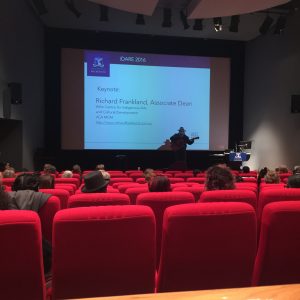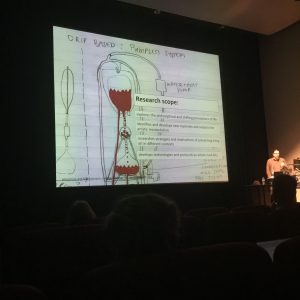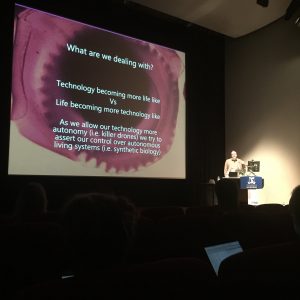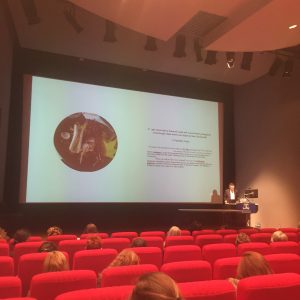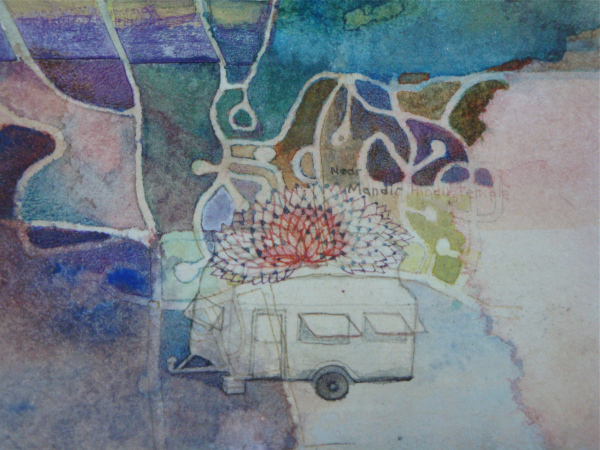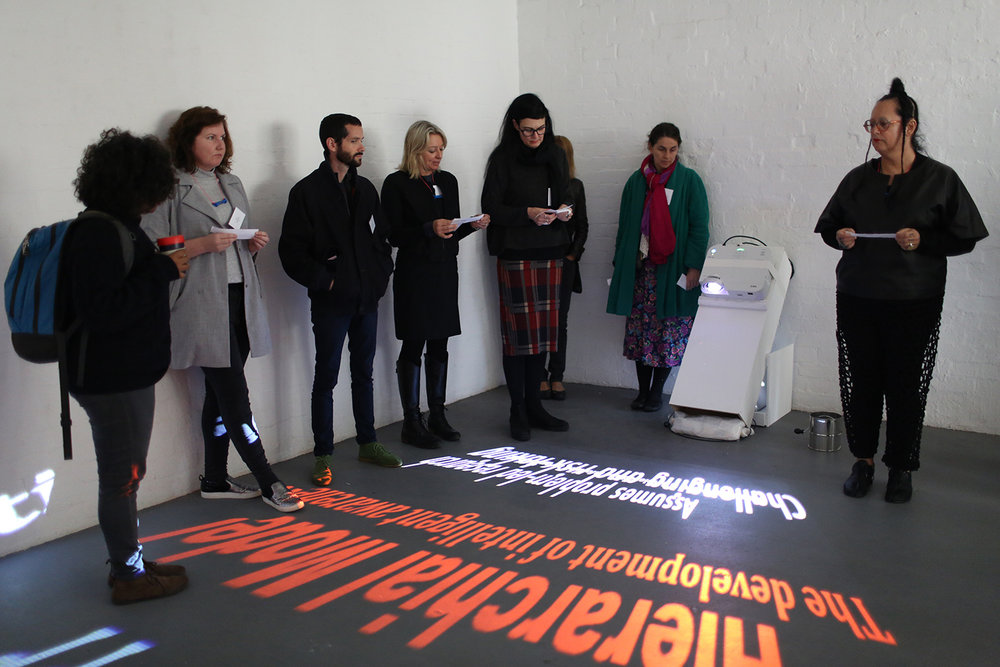Name: Dr Toby Juliff
Doing: Lecturer and artist, supervising across practice and theory, VCA and MCM, University of Melbourne.
Project description:
In this case study Dr Toby Juliff discusses his art practice collaborations, his academic practice as a supervisor of higher degrees by research (HDR), and his interactions with and on the ethics advisory board at the VCA MCM, University of Melbourne.
Toby teaches into the undergraduate art program, and is the Honours Coordinator at the VCA and he is currently supervising five PhD students. His supervision experience is based in fine art, production, and contemporary music, and has supervised 11 HDR completions (2 PhD, 9 MFA and Masters by research).
My background is as a theoretician. I undertook a theoretically minded PhD… I do have a background as a [sculpture] practitioner, but not recently in the last decade or so. I work mostly in critical and theoretical forms.
Ethics process experience:
Toby discussed how he integrates the ethics process into supervisions:
In supervision, we analyse the next stage of the project, and we take an evaluation of wherever a project may encompass a third party, an external or internal party, participants and collaborations. From this, we would have to evaluate the necessity of an ethics application. I would, of course, advise them to undertake ethics training at that point. And many of them have done so as part of their research training any, which is a relatively new thing I think, but it’s a very, very welcome one.
We will then look at a series of models provided by the research office together. Some that have passed, and some that haven’t. And we’ve looked at the questions of why they haven’t been passed. In most cases we put forward the proposal, and we take on board the advice. I’m happy to say that most of my applications have been very successful. I think that might be the insight I had of being on the ethics advisory board, although of course I don’t sit on any discussion of my own students. But I think that in terms of writing plain language statements and participant letter, etc. I think those models are very, very useful.
I think, I play a more cautious game; anything that involves a collaboration, participation, interview requires ethics. Although I don’t necessarily subscribe to the form of the ethics application, which I think is somewhat arduous a lot of the time, and based around other disciplinary factors, I do play rather cautiously on that point. So any student of mine who wishes to incorporate any outcome from an interview or participation will fill out an ethics application. And I think that should be standard.
Project issues:
In discussing his art practice and supervision, Toby bought up the critical issue of collaboration with other artists and how, in his experience, it is a/effected by the formalisation of the ethics process which changes perspectives and contexts on how artists work collaboratively with participatory practices.
I can give an example of an ethics application I’ve made myself. I was following up a peer-reviewed journal publication that I’d completed a year or so ago. I was invited to follow that up through dialogue with some of my frequent collaborators, some of whom I had been practicing alongside for 10 years or so (through exhibitions, publications, collaborations and friendships). Now those practices and formations of that network were formed over time and based around trust, and based around frequent collaborations.
In my own ethics application, however, I was forced to confront and re-evaluate that informal relationship and to professionalise it. To ask my friends, many of whom I’d interviewed many, many times, to interview them in a different way. And for me, that highlighted perhaps a problem that we have that the nature of creative collaborations. These participations are often born out of different sets of relations to that of the social sciences and the human sciences.
I found myself being very uncomfortably, being forced with chatting to a friend who I’d known for 10 years, and collaborated with on a number of projects, to saying ‘you need to sign this form’. And they’d just say ‘what are you talking about?’
And I think that also, within that, by being fostered to a certain degree in essentially determining the direction and format of the interview process, I think I shut off certain possibilities that might have been opened up in a more free-formed interview format, where it could go anywhere. And the possibility that the conversation could open up new fields of inquiry, [and] new questions. I felt that in my predetermination of my questions and their outcome, I found as though it was maybe counter-intuitive to the nature of our previous collaborations.
His discussion of collaboration brings into focus the issue of dependency in relations between researcher and the researched, and the position of co-researchers and participation. The position of the researcher is one that needs thought by the artist, (supervisory team if involved) and the ethics board as it can change relationships within collaborations and the kinds of generative participation practices and creative research methods may entail.
For me, participation is a question whereby the participants will play an active role in determining the outcome of the work, as opposed to merely being respondents to the work. And often in the ethics advisory board I encounter two forms: those that encourage participants, whether they be members of the public or practitioners themselves, to reflect upon a process; and those who actively participate in the creation of a work. For me, participation is collaborative and generates an outcome, as opposed to that which is a response.
We need to look at better defining what we understand by participation, and collaboration, and also what the responsibility is when it goes, not necessarily up to those levels, but sometimes beyond it as well.
I think that actually undergoing a sort of ethics review, even if it’s not necessary, can often be useful. And I think that it can be useful for students to posit ‘well, how would so and so respond to it?’ ‘Who is my other to this?’ ‘Who is my audience for this?’ ‘And what might my own response be to a question?’ It can often be generative in a critical sense. We often undertake those processes at the same time. The majority of the students I work with are often minimal risk. I very rarely work with students that aren’t. And that’s nothing to do with me, it’s to do with their projects. I think it’s a useful exercise nonetheless, even if it doesn’t necessarily require the formal ethics application.
I often caution students against simply applying qualitative research models without actually understanding what it is that’s generated from that. I’ve done enough sociological research myself to realise that doing interviews can generate a lot of information, but without the right questions, and without the right frame in mind, and the right question, then the interview is completely useless. So I think the ethics can lead us to imagine what the research methodologies, and their applicability, are for qualitative models, or to ethnographic models, particular-like community models, etc.
Further in discussion, Toby discussed his supervisory relationships, supervisor training in ethics and the role of the “responsible researcher”, and the development of ethics reviews with his candidates he supervises.
I take the responsibility of being the responsible researcher seriously. So ultimately, anything that goes wrong comes back to me. I have to take an active role. I think some of my colleagues don’t necessarily understand the seriousness of that. And I think I do, because I think that I have seen, not necessarily projects that I’ve been involved with, but I’ve seen other projects where that hasn’t been taken all that seriously. Instances where supervisors haven’t necessarily realised that, and I think that they’ve been a little bit surprised when things have gone wrong.
It’s also about fostering good working relationship with your supervisees, as well. Getting to know their project better, the ins and outs of their framework. What can often appear a very discursive project can actually, when you’re talking about ‘well, who are you interviewing?’ Then suddenly we understand the project better. So that’s my hope.
I think that supervisory training, particularly with regards to ethics applications, should be alive to the responsibility to those needs and to be regularly reviewed, and regularly updated. As somebody who is still relatively new—I have completions at Masters and PhD, but I still consider myself junior, I consider myself to be reasonably fresh – but I do wonder how fresh I need to be if I’m signing off on my own students’ ethics applications. I think it should be integrated within supervision training.
In conclusion:
…I don’t necessarily see ethics as being a question of risk management or minimising risk. I think it has to do, particularly in the creative arts, about minimising challenges to the integrity of a given project. So I would encourage my students to sometimes ask the difficult questions, and certainly we look at antagonistic practices within participation, and modes of social practice, and I don’t discourage them from that. I only discourage them from not taking anything for granted. And I think that’s different.
I don’t want to call into question the university’s commitment to challenging works. I think that is too cynical. I think the caution sometimes comes at the supervisory level. I think that we are somewhat self-censoring, perhaps. We don’t want the angry Andrew Bolt article [Australian journalist working for the Herald Sun newspaper]. We don’t want to appear on the front page of the newspaper, even if to appear so would actually generate significant critical debate. I think it’s sometimes self-censorship, and I think it’s to do with our own caution. I don’t think I necessarily question the university’s commitment to challenging artwork. I think I question our own, the art school’s commitment to it.
To add to it is that I think that the demographic of many student researchers in creative practice is very different to those in other disciplines. I have many students that are older than myself, and have even a more established career than myself. They might not have a PhD, but they have 25 years of artistic practice. They have a dealer, they have a network, they have sets of practices that bewilder ethics committees. Sometimes, we have people who have set up entire creative industries, creative companies, and may well be the leading figure within their own field.
And I think that’s somewhat different from other forms. So I think that the demographic is somewhat different in the creative practices still. A number of my students have very well-established profiles. And I think that because of that, the networks that they’ve created, spent many, many years creating, need to be taken into account.
More about Dr Toby Juliff:
Thesis/practice link:
Toby Julliff & Travis Cox
The Post-display Condition of Contemporary Computer Art https://emajartjournal.com/2015/04/14/toby-juliff-travis-cox-the-post-display-condition-of-contemporary-computer-art/
Dr Toby Juliff was interviewed by Megan McPherson, May 2016.
For the iDARE conference, the CREW generated a series of interlinked contributions:
BAGS: About 70 CREW@iDARE bags where distributed to conference delegates at registration, each containing a series of objects inviting participation and reflection on the nature of ethics. The range of objects are more fully documented on this page, but importantly invited people to contribute to the CREW exhibition.
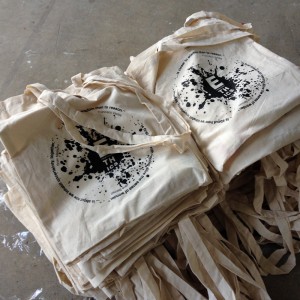
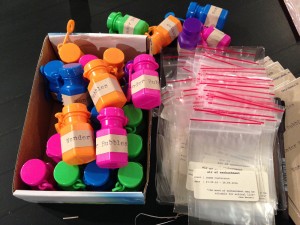
Images: Caitlyn Parry/ Caitlyn Parry
EXHIBITION: The exhibition operated across three rooms – which were understood to activate three conditions the CREW saw to be key concerns in relation to institutional ethics: 1. pre-emptive anxiety – 2. dialogue and the negotiations of difference, and 3. reflective deliberation. Conference delegates were invited to draw on stickers and cards and put them up in the reflective deliberation room. Contributions are documented below – some beautiful thoughts, observations and moments are recorded therein, also partially offering a trace of the issues discussed in the workshop/performance events….
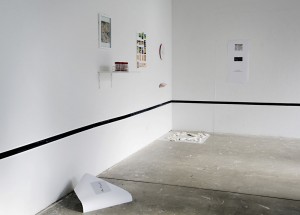
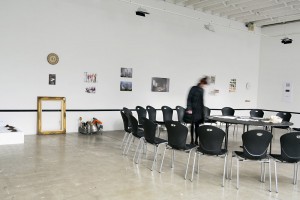

Images: Kate Robertson/ Kate Robertson/ Caitlyn Parry
WORKSHOP/PERFORMANCES: Across two hour long sessions as part of the conference, the CREW staged events in the exhibition space. The first involved a performative engagement with the three rooms of the exhibition, in which all CREW members present generated a collective voice. This was followed by a robust discussion with responses from conference keynotes Jane Rendell and Stephen Loo. The second event on the next day followed on from the former but focussed largely on continuing the round table discussion in the central room, provocatively kicked off by conference keynote, Oron Catts. VCA’s Danny Butt offered an insightful summary of the issues discussed.
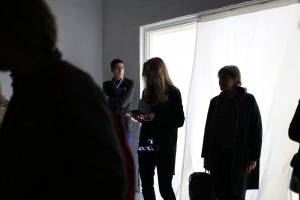

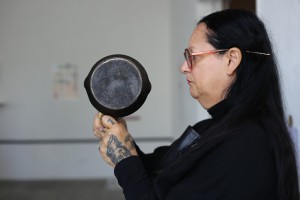
Images: Caitlyn Parry/ Caitlyn Parry/ Caitlyn Parry
CARDS: The CREW is interested in the way that one’s ongoing development of ethical know-how is embedded in everyday life – where research into ethical conduct occurs as integral to one’s experience. In response to the assumption embedded in university ethics application forms regarding a separation between research and everyday life and the absurdity of the Plain Language Statement in many related situations, the CREW members gave out cards to conference delegates aimed to provoke related issues.
Further info and photos on http://www.aelab.org/the-crew-idare-exhibition
Thank-you to the CREW and aelab for the CREW report republished from http://www.aelab.org/the-crew-idare-exhibition
About CREW
During the IDARE conference the CREW held an activity on each day of the conference. For information about the iDARE conference CREW activities: http://www.aelab.org/the-crew-idare-exhibition
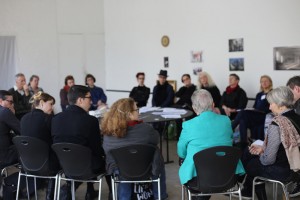

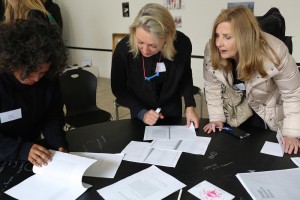
Images: Caitlyn Parry/ Caitlyn Parry/ Caitlyn Parry
CREW Session 1
Round Table: a collective presentation and discussion in the CREW exhibition
VCA Student Gallery
Respondents: Jane Rendell and Stephen Loo
the CREW: Pia Ednie-Brown, Elmedin Zunic, Citt Williams, Juliana Espana Keller, Indira Shanahan, Kate Robertson, Melissa Razuki, Chloe Sobejko, Caitlyn Parry, Chris Kohn, Shannon Owen, Jaden Hastings, Kym Maxwell, Andrew Goodman, Maite Galarza.
CREW Session 2
Ethics-in-Action: an exhibition-event
VCA Student Gallery
Respondents: Oron Catts and Stephen Loo
the CREW: Pia Ednie-Brown, Elmedin Zunic, Citt Williams, Juliana Espana Keller, Indira Shanahan, Kate Robertson, Melissa Razuki, Chloe Sobejko, Caitlyn Parry, Chris Kohn, Shannon Owen, Jaden Hastings, Kym Maxwell, Andrew Goodman, Maite Galarza.
